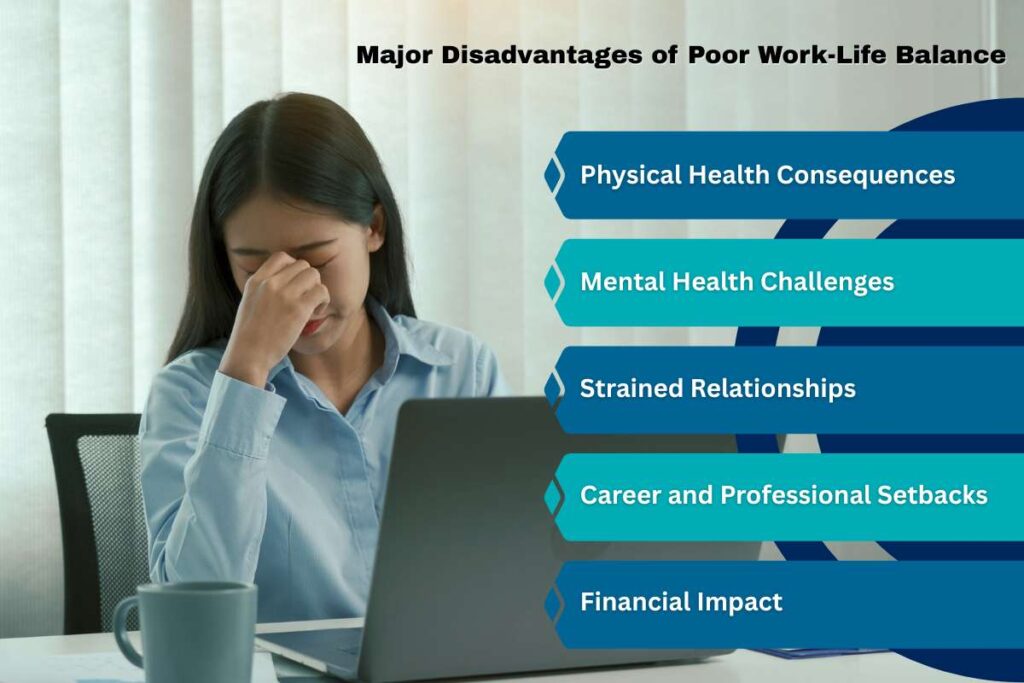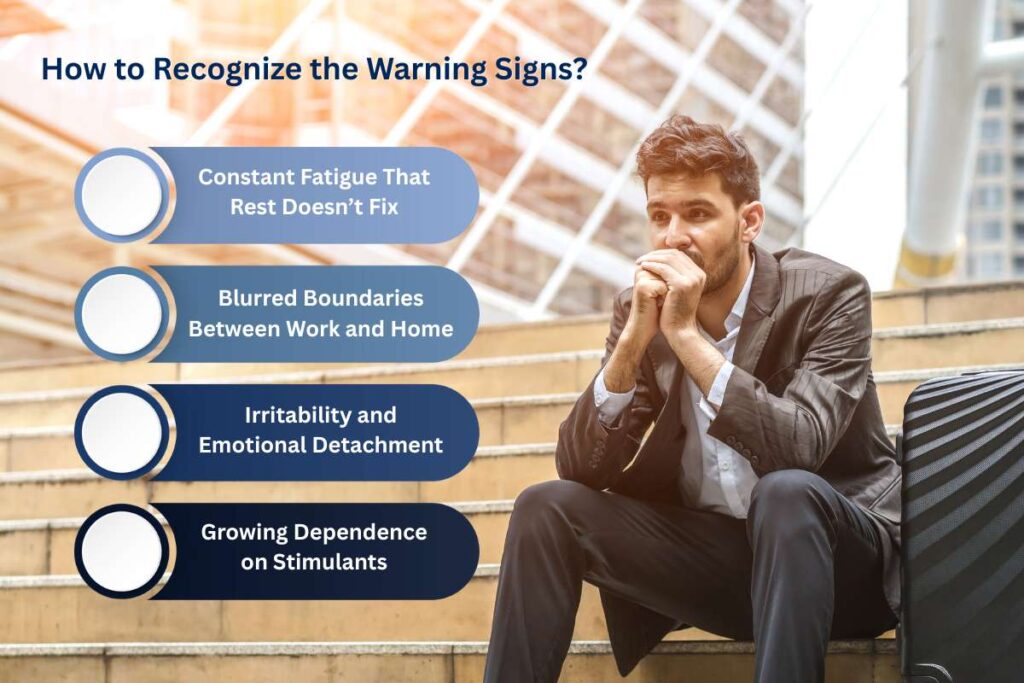You sit down for dinner, hoping to finally relax, but your phone buzzes. Another “urgent” email. You tell yourself it’ll only take a minute, yet by the time you look up, the meal is over and the moment is lost. Sound familiar?
That’s the everyday reality of poor work-life balance. At its core, work-life balance is simply the ability to manage your job without sacrificing your health, family, or personal time. But with endless notifications, remote work blurring boundaries, and the pressure to always be available, finding that balance has become harder than ever.
Research makes the picture clear: Deloitte reports that 77% of professionals have faced burnout, while Gallup found that 43% of workers feel stressed at work every single day. These aren’t just numbers; they’re signs of a growing problem.
The disadvantages of poor work-life balance aren’t just about feeling tired. They ripple through your life, affecting your physical health, mental well-being, relationships, career growth, and even long-term happiness. Left unchecked, the cost of imbalance is far greater than many people realize.
Why Work-Life Balance Matters Today?

Work used to stay at the office, but now, the office is wherever your phone is. Remote and hybrid work models have blurred the boundaries between personal time and professional demands. According to Microsoft’s Work Trend Index, 40% of employees check email before 6 a.m., while evening meetings after 8 p.m. have jumped 16% year-over-year.
This constant connectivity means even the weekends aren’t safe: nearly one in five employees check emails before noon on Saturday or Sunday, and over 29% dive back into their inboxes after 10 p.m. Amidst this “infinite workday,” Microsoft also found that employees are interrupted, on average, every two minutes, adding up to 275 distractions per workday.
The result? A growing health risk. The World Health Organization reports that working 55 hours or more per week is linked to a 35% higher risk of stroke and a 17% higher risk of dying from ischemic heart disease compared to a standard 35–40 hour week. In fact, long working hours are now recognized as the occupational risk factor with the largest associated burden of disease: about 745,000 global deaths in 2016 were attributed to overwork due to stroke and heart issues.
On the flip side, people are recognizing the value of balance more than ever. LinkedIn’s 2024 Global Talent Trends report found that 63% of employees would prioritize work-life balance over higher pay, showing that well-being is no longer optional; it’s essential.
5 Major Disadvantages of Poor Work-Life Balance

The truth is, hustling without boundaries doesn’t make you more successful; it chips away at your health, happiness, and even your future income. The disadvantages of poor work-life balance often start small, skipping sleep, missing dinner, working “just one more hour,” but over time, the hidden costs add up in ways most people never expect.
1. Physical Health Consequences
When the body is constantly under pressure, it pays the price. The American Heart Association found that chronic stress significantly raises the risk of high blood pressure and cardiovascular disease. Lack of rest also triggers hormonal imbalances that can lead to obesity and type 2 diabetes.
A Harvard Medical School study revealed that people who sleep fewer than 6 hours a night are 30% more likely to develop heart problems. Fatigue also weakens immunity, making it harder to fight everyday infections.
2. Mental Health Challenges
The emotional toll may be even heavier. The American Psychological Association reported that 79% of employees frequently feel stressed at work, with nearly 3 in 5 experiencing negative impacts like lack of interest, motivation, or energy.
Beyond stress, prolonged imbalance fuels burnout, anxiety, and depression. Research from the National Institute of Mental Health (NIMH) shows that unmanaged workplace stress can lead to long-term mood disorders and cognitive decline.
3. Strained Relationships
Time is the most valuable gift we can give others, and when work steals it, relationships suffer. A Pew Research Center survey found that 33% of parents say their job keeps them from spending enough time with their children.
Couples aren’t immune either. Studies in the Journal of Marriage and Family show that long work hours are directly linked to higher levels of marital dissatisfaction and conflict. Disadvantages of poor work-life balance isolate individuals, making them feel disconnected from their own support systems.
4. Career and Professional Setbacks
Ironically, overworking doesn’t always mean overachieving. The Organization for Economic Cooperation and Development (OECD) found that countries with shorter average workweeks, like Denmark and Germany, consistently report higher productivity per hour than nations with longer hours.
This proves that one of the biggest disadvantages of poor work-life balance is reduced effectiveness. Exhausted employees are more prone to errors, less creative, and more likely to burn out, leading to stalled promotions, job dissatisfaction, or sudden career changes.
5. Financial Impact
Stress has a price tag. The World Economic Forum estimates that poor mental health alone could cost the global economy $6 trillion annually by 2030 due to lost productivity and rising healthcare expenses.
On a personal level, mounting medical bills, missed opportunities, and diminished career growth make a poor balance financially draining. Over time, these hidden costs erode not only savings but also long-term earning potential.
Advantages of Work-Life Balance Vs Disadvantages of Poor Work-Life Balance
| Aspect | Healthy Work-Life Balance | Disadvantages Poor Work-Life Balance |
| Physical Health | Rested, lower disease risk | Higher risk of heart disease, obesity, and diabetes (heart.org) |
| Mental Well-being | Focused, motivated | Burnout, anxiety, depression (apa.org) |
| Relationships | Strong connections | Missed family time, marital conflicts (pewresearch.org) |
| Career Growth | Productive, innovative | Declining productivity, career stalls (oecd.org) |
| Financial Impact | Steady growth, security | Rising medical bills, lost earnings (weforum.org) |
Real-Life Examples
We often think of overworking as just being “tired” or “busy,” but the data tells a much harsher story. The disadvantages of poor work-life balance are measurable and, in many cases, dangerous.
The World Health Organization (WHO) has shown that working more than 55 hours a week increases the risk of stroke by 35% and heart disease by 17%. That means extra hours at your desk don’t just steal time from your personal life; they may literally take years off your life.
The workplace effects are equally striking. A Gallup survey revealed that 76% of employees experience burnout at least sometimes, while nearly a third feel burned out “very often” or “always”. Burnout isn’t just about mood; it makes employees 63% more likely to call in sick and almost three times more likely to look for another job.
Deloitte echoes this trend, reporting that 77% of professionals have experienced burnout at their current job, with 91% admitting that stress impacts their work quality. In other words, imbalance doesn’t just hurt workers; it drains companies of productivity and creativity.
A Real-World Story: Karoshi in Japan

Japan even coined a word for death from overwork—KAROSHI. Cases of karoshi, often caused by heart attacks or strokes linked to extreme working hours, gained global attention in the 1980s. A well-known case in 2015 involved a 24-year-old employee at Dentsu, one of Japan’s largest ad agencies, who tragically died after logging over 100 hours of overtime in a single month.
This extreme example underscores a universal truth: when work consumes life, the consequences can be devastating. The disadvantages of poor work-life balance aren’t just abstract; they show up in real tragedies, lost productivity, and rising health crises across the globe.
Long-Term Disadvantages of Poor Work-Life Balance
Chronic disadvantages of poor work-life balance stretch over years instead of weeks, the effects compound, and the damage isn’t just physical. It reshapes health, happiness, and even family dynamics for generations.
1. Chronic Stress Becomes a Silent Killer
Stress is fine in short bursts, but chronic stress chips away at your body like rust on steel. Studies show that chronic stress accelerates biological aging and increases the risk of early mortality by 43%. It also fuels long-term conditions like hypertension, type 2 diabetes, and cardiovascular disease, creating a health time bomb that explodes years later.
2. Decline in Life Satisfaction and Happiness
It’s not just about physical health; imbalanced lives leave people feeling unfulfilled. The World Happiness Report (WHR)consistently links excessive work hours to lower life satisfaction scores across countries. In fact, employees who spend more than 50 hours a week at work report being 20% less likely to describe themselves as “happy” compared to those with balanced schedules. Over time, that dissatisfaction translates into disengagement at work and disconnection at home.
3. Generational Impact: The Invisible Ripple
Perhaps the most overlooked disadvantage of poor work-life balance is how it shapes the next generation. Research by Harvard Business School found that children of parents who consistently worked long hours reported higher feelings of neglect and lower emotional connection. These kids are more likely to carry forward stress-driven habits, continuing the cycle of imbalance into their own careers.
How to Recognize the Warning Signs?

The disadvantages of poor work-life balance don’t always appear overnight. Instead, they creep in slowly, small signals that something is off. Spotting these early can mean the difference between a quick reset and long-term damage.
1. Constant Fatigue That Rest Doesn’t Fix
If you wake up tired even after a full night’s sleep, it’s more than “just a busy week.” Research shows that chronic overwork leads to sleep disturbances in nearly 40% of employees (Sleep Foundation). Fatigue becomes a cycle, draining energy, lowering focus, and increasing the risk of mistakes.
2. Blurred Boundaries Between Work and Home
Answering emails during family dinners or finishing reports from bed may feel harmless, but it signals an imbalance. A Microsoft study found that remote workers logged an average of 4 extra hours per week compared to pre-pandemic norms (Microsoft Work Trend Index). Over time, this erases personal downtime and fuels burnout.
3. Irritability and Emotional Detachment
Snapping at loved ones, avoiding social interactions, or feeling emotionally “numb” are common warning signs. The American Institute of Stress reports that 54% of workers cite stress as the cause of workplace fights or arguments. This not only damages relationships but also feeds isolation. This is one of the recurring disadvantages of poor work-life balance.
4. Growing Dependence on Stimulants
When coffee, energy drinks, or even alcohol become coping tools, it’s a red flag. A Johns Hopkins study revealed that over 67% of adults rely on caffeine daily, but excessive intake worsens anxiety and sleep issues. Paired with alcohol use as a “stress escape,” it becomes a dangerous cycle.
Expert Insights & Credibility
The disadvantages of poor work-life balance aren’t just opinions—they’re backed by years of research and expert consensus.
- Dr. Christina Maslach, a psychologist at UC Berkeley and leading burnout researcher, explains: “Chronic imbalance between work and life isn’t sustainable. It doesn’t just drain energy; it erodes identity and purpose over time.” (UC Berkeley)
- The World Health Organization (WHO) has officially classified burnout as an “occupational phenomenon,” linking it directly to unmanaged workplace stress.
- According to the Harvard Business Review, employees working over 55 hours a week show a 20% drop in productivity despite working longer (HBR). This proves that more hours don’t equal better results; they often mean worse.
- The American Psychological Association (APA) highlights that three in five employees report negative mental health impacts from work-related stress, showing how imbalance directly translates into anxiety and depression.
These expert voices emphasize that ignoring work-life balance isn’t a badge of dedication; it’s a direct path to burnout, poor health, and lost potential.
Turning Disadvantages Into Lessons
The good news? The disadvantages of poor work-life balance don’t have to be permanent. Companies are now adopting flexible schedules, four-day workweeks, and digital detox policies, while individuals are learning to set boundaries and prioritize downtime.
The lesson is clear: balance isn’t a luxury, it’s a strategy for long-term success. Small changes today can prevent long-term health problems, repair strained relationships, and create a more meaningful career journey.
Conclusion
At its core, the disadvantages of poor work-life balance go far beyond late nights at the office. They affect your health, your happiness, your family, and even your financial future. The costs are real, but so are the solutions.
Now is the time to pause and ask: Am I working to live, or living to work? Reflecting on that simple question could be the first step toward protecting both your well-being and your future.
FAQs: Disadvantages Of Poor Work-Life Balance
1. What are the disadvantages of poor work-life balance?
They include chronic stress, burnout, physical illnesses (like heart disease), strained relationships, reduced productivity, and long-term career setbacks.
2. How does poor work-life balance affect health?
It increases the risks of cardiovascular disease, sleep disorders, anxiety, and depression while weakening the immune system.
3. Can poor work-life balance impact career growth?
Yes. Long hours often reduce productivity, creativity, and job satisfaction, which can slow promotions and lead to burnout-driven career changes.
4. How do you deal with the disadvantages of poor work-life balance?
By setting work boundaries, practicing digital detox, prioritizing health, and embracing flexible work arrangements when possible.


















